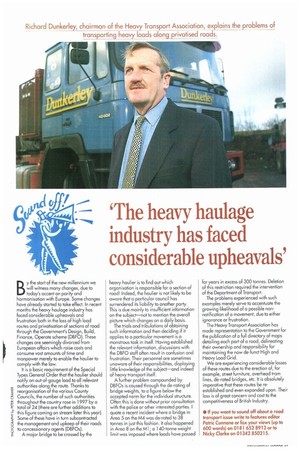The heavy haulage industry has faced considerable upheavals'
Page 43

If you've noticed an error in this article please click here to report it so we can fix it.
By the start of the new millennium we will witness many changes, due to today's accent on parity and harmonisation with Europe. Some changes have already started to take effect. In recent months the heavy haulage industry has faced considerable upheavals and frustration both in the loss of high load routes and privatisation of sections of road through the Government's Design, Build, Finance, Operate scheme (DBF0). These changes are seemingly divorced from European affairs which raise costs and consume vast amounts of time and manpower merely to enable the haulier to comply with the law.
It is a basic requirement of the Special Types General Order that the haulier should notify an out-of-gauge load to all relevant authorities along the route. Thanks to reorganisation of the various County Councils, the number of such authorities throughout the country rose in 1997 by a total of 24 (there are further additions to this figure coming on stream later this year). Some of these have in turn subcontracted the management and upkeep of their roads to concessionary agents (DBF0s). A major bridge to be crossed by the heavy haulier is to Find out which organisation is responsible for a section of road! Indeed, the haulier is not likely to be aware that a particular council has surrendered its liability to another party. This is due mainly to insufficient information on the subject—not to mention the overall picture which changes on a daily basis.
The trials and tribulations of obtaining such information and then deciding if it applies to a particular movement is a monstrous task in itself. Having established the relevant information, discussions with the DBFO staff often result in confusion and frustration. Their personnel are sometimes unaware of their responsibilities, displaying little knowledge of the subject—and indeed of heavy transport itself.
A further problem compounded by DBFOs is caused through the de-rating of bridge weights, to a figure below the accepted norm for the individual structure. Often this is done without prior consultation with the police or other interested parties. I quote a recent incident where a bridge in Area 5 on the M4 was de-rated to 38 tonnes in just this fashion. It also happened in Area 8 on the Ml; a 140-tonne weight limit was imposed where loads have passed for years in excess of 300 tonnes. Deletion of this restriction required the intervention of the Department of Transport. The problems experienced with such examples merely serve to accentuate the growing likelihood of a possible nonnotification of a movement, due to either ignorance or frustration. The Heavy Transport Association has made representation to the Government for the publication of a full directory of maps detailing each part of a road, delineating their ownership and responsibility For maintaining the now de-funct High and Heavy Load Grid. We are experiencing considerable losses of these routes due to the erection of, for example, street furniture, overhead tram lines, de-rated bridges, etc. It is absolutely imperative that these routes be reestablished and even expanded upon. Their loss is of great concern and cost to the competitiveness of British Industry.
• If you want to sound off about a road transport issue write to features editor Patric Cunnane or fax your views (up to 600 words) on 0181 652 8912 or to Nicky Clarke on 01342 850215.
































































































